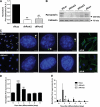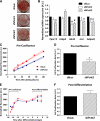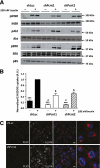Genetic defects in human pericentrin are associated with severe insulin resistance and diabetes
- PMID: 21270239
- PMCID: PMC3046854
- DOI: 10.2337/db10-1334
Genetic defects in human pericentrin are associated with severe insulin resistance and diabetes
Abstract
Objective: Genetic defects in human pericentrin (PCNT), encoding the centrosomal protein pericentrin, cause a form of osteodysplastic primordial dwarfism that is sometimes reported to be associated with diabetes. We thus set out to determine the prevalence of diabetes and insulin resistance among patients with PCNT defects and examined the effects of pericentrin depletion on insulin action using 3T3-L1 adipocytes as a model system.
Research design and methods: A cross-sectional metabolic assessment of 21 patients with PCNT mutations was undertaken. Pericentrin expression in human tissues was profiled using quantitative real-time PCR. The effect of pericentrin knockdown on insulin action and adipogenesis in 3T3-L1 adipocytes was determined using Oil red O staining, gene-expression analysis, immunoblotting, and glucose uptake assays. Pericentrin expression and localization also was determined in skeletal muscle.
Results: Of 21 patients with genetic defects in PCNT, 18 had insulin resistance, which was severe in the majority of subjects. Ten subjects had confirmed diabetes (mean age of onset 15 years [range 5-28]), and 13 had metabolic dyslipidemia. All patients without insulin resistance were younger than 4 years old. Knockdown of pericentrin in adipocytes had no effect on proximal insulin signaling but produced a twofold impairment in insulin-stimulated glucose uptake, approximately commensurate with an associated defect in cell proliferation and adipogenesis. Pericentrin was highly expressed in human skeletal muscle, where it showed a perinuclear distribution.
Conclusions: Severe insulin resistance and premature diabetes are common features of PCNT deficiency but are not congenital. Partial failure of adipocyte differentiation may contribute to this, but pericentrin deficiency does not impair proximal insulin action in adipocytes.
Figures




References
-
- Reaven GM. Pathophysiology of insulin resistance in human disease. Physiol Rev 1995;75:473–486 - PubMed
-
- Lee JM, Okumura MJ, Davis MM, Herman WH, Gurney JG. Prevalence and determinants of insulin resistance among U.S. adolescents: a population-based study. Diabetes Care 2006;29:2427–2432 - PubMed
-
- Kahn SE, Hull RL, Utzschneider KM. Mechanisms linking obesity to insulin resistance and type 2 diabetes. Nature 2006;444:840–846 - PubMed
-
- Rung J, Cauchi S, Albrechtsen A, et al. Genetic variant near IRS1 is associated with type 2 diabetes, insulin resistance and hyperinsulinemia. Nat Genet 2009;41:1110–1115 - PubMed
Publication types
MeSH terms
Substances
Grants and funding
LinkOut - more resources
Full Text Sources
Medical

